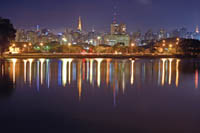Of contrasts and contradictions

Sao Paulo, Brazil’s commercial centre, is big by any definition. Taking the total metropolitan area, the city has a population of 29 million, making it the second largest city in the world.
Greater Sao Paulo, without the hinterland has a population of 19.7 million, which ranks it as the fifth most populous city in the world and the largest in the Southern Hemisphere.
So how did all this come about? Sao Paulo’s history dates back to the 16th century, when it was founded by Jesuit missionaries and later was the base for the bandeirantes (explorers) looking for and finding gold and diamonds.
Afterwards came the coffee for which Brazil has become so famous all over the globe, and later heavy industry was introduced. Today, the services with the many banks, universities, company headquarters and commercial offices are coming very much to the fore.
Whatever the reason for visiting Sampa, as the city is known to its citizens – to watch the famous soccer matches or the Brazilian Grand Prix – any visitor will be left gob-smacked by its hustle and bustle.
The city has a myriad of skyscrapers, ubiquitous helicopters and extensive metro system, even smog (yes, it has taken over from London in this regard) and the multi-cultural mix of the descendants of the Portuguese, Italians, Lebanese, Japanese, Spanish and Germans, who make up this vibrant cosmopolitan city.
The city offers some sixty kilometres of underground railways, known as the Metro. Again one has to start using superlatives, as it is one of the largest subways on the planet.
The two things I always associated with Brazil, before arriving there for the first time many years ago, were coffee and the samba.
Sao Paulo is a major cultural centre and it is still famous for the samba, a very exciting dance with origins in Portugal and Africa. It faded slightly in the 1980s, when the Bossa Nova and hard rock stole the limelight, but it is now as popular ever – and a joy to watch with the billowing and colourful dresses worn by the lady dancers and the intricate movements of their male partners. These are innumerable dance restaurants all over the city where visitors can catch the rhythm.
Coffee is a link to Arabia, for it was from here this beverage became popular before being exported to Italy and later to the then colonial North America, where it was chosen instead of tea which was heavily taxed by the British – and then on to South America.
Sao Paulo’s coffee farmers became exceedingly wealthy, but world wars and depressions encouraged them to look elsewhere and they invested in industry, heavy industry at that. Today, this industry is still vital, but Sao Paulo has now become an important commercial centre. However, it is still a popular moment to take home a box of Brazilian coffee as a souvenir.
Sao Paulo is a city of contrasts and contradictions. There is the raw evidence of relentless development with the power lines draped across the city and the largest private helicopter fleet in the world, helping the wealthy inhabitants to avoid the downtown traffic jams.
And there is the quietness of art museums like Pinacoteca do Estado and a multitude of small bars serving Brazilian specialities like beef stroganoff or prestigious shops in the upmarket areas like Rua Oscar Freire offering the latest international and Brazilian brands.
Sao Paulo is so big, it is difficult to know where to start to explore… I was advised as follows: Avenida Paulista for cracking photo shots of some of the world’s great skyscrapers. The Jardin area for shopping – ceramics, leather, wood carvings, lace, paintings and jewellery are all good buys, but note shops are closed on Saturday afternoons.
Places of interest not to be missed are the Teatro Municipal, the Planetarium in the Parque do Ibirapuera, a huge public park. The Sao Museo de Arte Sacra and Jardin do Luz in an 18th century monastery with collections of colonial art and artifacts. And if you are feeling peckish, there are over 12, 000 restaurants to choose from, including 5,000 pizzerias.
But, after all the superlatives have been exhausted, the gifts bought, the camera digital memory filled and the last sumptuous pizza eaten, it will be the people, which will remains your fondest memory, for this melting pot of nationalities is the very heart of Sao Paulo.
